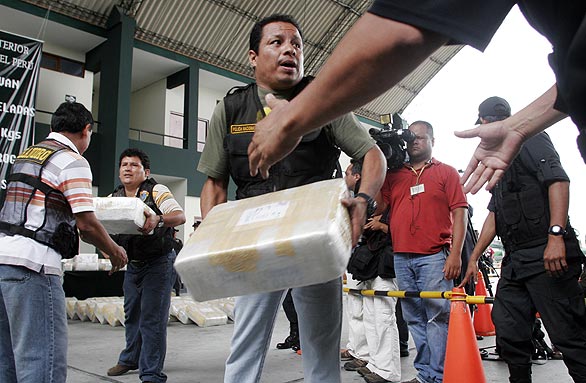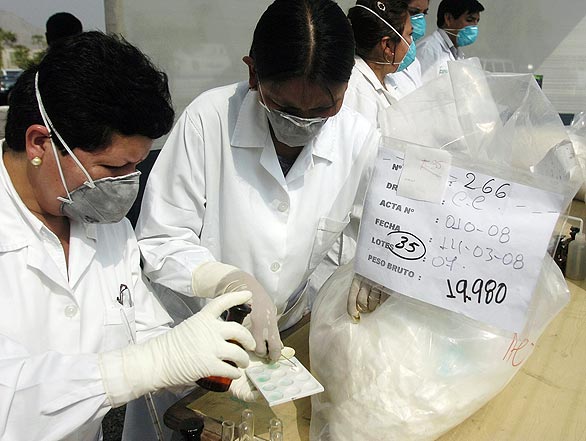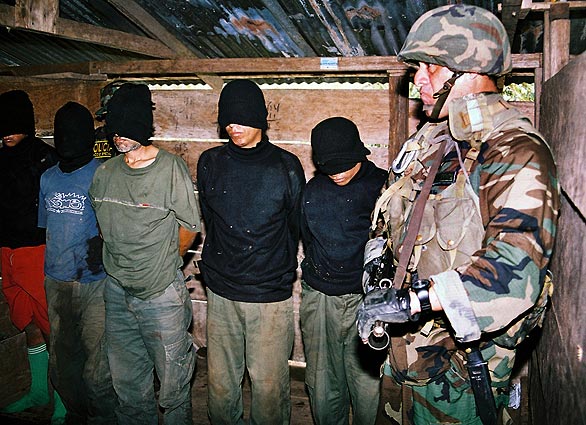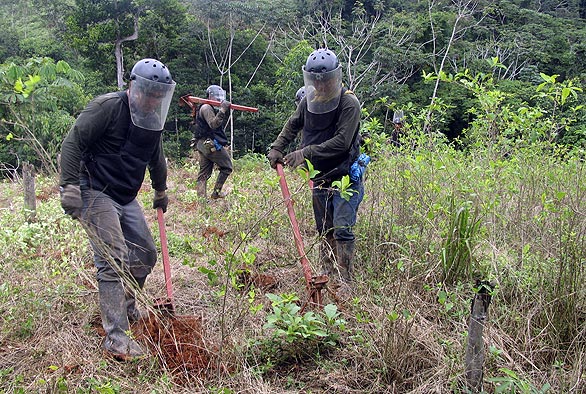 (above) March 10, 2008 Peruvian anti-narcotics police transport confiscated bricks of cocaine after a news conference in Lima. Peru’s cocaine industry, the world’s largest and most violent in the late 1980s and early 1990s, is again on the upswing. (Photo: Enrique Castro-Mendivil / Reuters)
(above) March 10, 2008 Peruvian anti-narcotics police transport confiscated bricks of cocaine after a news conference in Lima. Peru’s cocaine industry, the world’s largest and most violent in the late 1980s and early 1990s, is again on the upswing. (Photo: Enrique Castro-Mendivil / Reuters)
Peru sees cocaine making a comeback
After a lull, production is rising, feeding demand in Brazil, Europe and East Asia, officials say. With flashy cartel men replaced by a piecemeal network, the trafficking is harder to combat.
March 23, 2008 - LA Times
By Patrick J. McDonnell, Los Angeles Times Staff Writer patrick.mcdonnell@latimes.com
SANTA LUCIA, PERU -- Rustic mule trains ferry vital chemicals to clandestine jungle labs.
Trekkers never seen on the Discovery Channel backpack the prized finished product on epic journeys from steamy Amazon hideaways to chilly highland distribution depots.
And a shadowy remnant of the notorious Shining Path rebel army, led by a charismatic man named Artemio, uses its muscle to pocket a fortune in a sinister protection racket.
Peru's cocaine industry, the world's largest and most violent in the late 1980s and early 1990s, is again on the upswing. Plots of coca bushes, whose leaves yield cocaine, have increased by about one-third since 1999, to about 127,000 acres, according to Peruvian and United Nations estimates.
 (above) March 18, 2008 Police test confiscated cocaine at a police base in Lima. Today, Peruvian traffickers produce pure cocaine for export, not the paste that was once regularly shipped to Colombia for final processing. (Photo: Karel Navarro / Associated Press)
(above) March 18, 2008 Police test confiscated cocaine at a police base in Lima. Today, Peruvian traffickers produce pure cocaine for export, not the paste that was once regularly shipped to Colombia for final processing. (Photo: Karel Navarro / Associated Press)
And this time, the traffickers may be more difficult to combat because the flashy kingpins from Colombia have been replaced by a piecemeal network, a sort of gold rush of international entrepreneurs.
Production is still well below the record highs of the early 1990s, and neighboring Colombia has surpassed Peru as the global cocaine leader, supplying 90% of the U.S. market, according to the State Department. Moreover, President Alan Garcia is a staunch foe of the drug.
"Peru will not resign itself to be a country of narco-trafficking," vowed the pro-U.S. Garcia, who took office in 2006.
 (left) February 21, 2008 A Peruvian policeman tosses bricks of cocaine into a fire. “Peru will not resign itself to be a country of narco-trafficking,” vowed Peruvian President Alan Garcia. (Photo: Aizar Raldes / AFP-Getty Images)
(left) February 21, 2008 A Peruvian policeman tosses bricks of cocaine into a fire. “Peru will not resign itself to be a country of narco-trafficking,” vowed Peruvian President Alan Garcia. (Photo: Aizar Raldes / AFP-Getty Images)
But Peru, the world's No. 2 supplier, feeds a booming demand in Brazil, Europe, East Asia and as far away as Australia, authorities say. The density of coca plantings has doubled in some cases, experts say, and the fertilizer-nourished leaf now yields a greater proportion of cocaine alkaloid, the active ingredient in cocaine.
A wave of drug-related lawlessness -- assassinations, ambushes, threats against prosecutors -- has fanned fears of the kind of narco-instability that afflicts Colombia and Mexico. The Tijuana cartel is suspected in the 2006 slaying in Lima, the Peruvian capital, of a judge hearing a case against an alleged cartel capo.
And renewed militancy among the peasants who grow the coca leaf has sparked road closures and violent clashes with law enforcement officers.
The Garcia administration initially agreed to suspend eradication efforts, a mainstay of the U.S.-backed anti-drug policy. But Garcia later reversed course and even suggested that clandestine laboratories be raided and bombed. With U.S. aid that totals about $50 million a year, Peru has trained and deployed hundreds of anti-drug police officers.
"If we don't kill the danger now," Garcia declared, Peru could be confronted with "an insurgency as large as occurred in our neighboring country" -- a reference to Colombia, where cocaine underwrites guerrilla armies.
Former Interior Minister Fernando Rospigliosi has warned of the corrosive effect of a burgeoning drug trade. "Its tentacles always reach to the halls of the highest authority," he said.
 (above) March 21, 2008 Suspected Sendero Luminoso, or Shining Path, guerrillas captured during a November 2007 raid that also yielded a large arms cache. The drug trade, authorities say, is stimulating a fresh incarnation of the group, which terrorized the nation before being beaten down in the 1990s. "Shining Path isn’t about ideology anymore,” said Gen. Juan Zarate, who heads Peru’s eradication effort. “Now it’s all about the narco-business.” (Photo: Peruvian Ministry of Interior)
(above) March 21, 2008 Suspected Sendero Luminoso, or Shining Path, guerrillas captured during a November 2007 raid that also yielded a large arms cache. The drug trade, authorities say, is stimulating a fresh incarnation of the group, which terrorized the nation before being beaten down in the 1990s. "Shining Path isn’t about ideology anymore,” said Gen. Juan Zarate, who heads Peru’s eradication effort. “Now it’s all about the narco-business.” (Photo: Peruvian Ministry of Interior)
During the 1990s, U.S.-backed enforcement efforts chased much of the coca trade to Colombia. Now, some say, the wheel is turning: Pressure in Colombia is shifting production here.
But today's tableau is distinct from the brazen scenario of the late 1980s and early '90s.
Gone are the Colombian drug barons swaggering around in opulent jungle redoubts such as the nearby town of Uchiza, once dubbed the world cocaine capital, with its gaudy discos and bordellos. Replacing the Colombians is a multinational network that reaches from the Amazon basin to a globalized market.
"We're up against an army of ants," said Gen. Miguel Hidalgo, who heads Peru's national anti-drug police.
Authorities here have identified smuggling rings from Mexico, Colombia, Brazil, Nigeria and the Dominican Republic, among other countries. A Peruvian gang allegedly headed by a petite woman known as Floricienta (after the lead character in an Argentine soap opera of the same name) is said to control a massive chemical-supply network.
 (above) "Eradicators" seek out coca plants in Peru's Upper Huallaga Valley during operations this year. The eradicators don helmets, eye protection and bulletproof vests to protect them from attacks and bombs. They use long lances to pull up coca bushes that may be booby-trapped. (Photo: Peruvian Special Project for the Control and Reduction of Coca in the Upper Huallaga)
(above) "Eradicators" seek out coca plants in Peru's Upper Huallaga Valley during operations this year. The eradicators don helmets, eye protection and bulletproof vests to protect them from attacks and bombs. They use long lances to pull up coca bushes that may be booby-trapped. (Photo: Peruvian Special Project for the Control and Reduction of Coca in the Upper Huallaga)
Today, Peruvian traffickers produce pure cocaine for export, not the paste that was once regularly shipped to Colombia for final processing.
U.S.-supported police efforts have shut down clandestine landing strips and pinched road access to the isolated planting districts on the Andes' lush eastern flanks. But ever-adaptable traffickers have expanded cultivation zones while employing pack animals and mochileros -- backpackers -- to maintain the illicit flow.
Negotiating extreme terrain, low-tech legions use mules to haul in the essential chemical precursors, and cocaine-laden backpackers stealthily travel age-old Inca trails beneath the canopy, creating invisible contraband thoroughfares.
"Everything is now done on a small scale, a lot of little pieces," said Col. Whitman Rios, head of special operations at the U.S.-supported anti-drug base here in the Upper Huallaga Valley, Peru's most notorious production zone.
This is an area of hypnotic natural beauty, where the mighty Huallaga River meanders through luxuriant hills and sumptuous flatlands like a chocolate-colored pretzel in a vast sea of green. From the air, there is no hint of the battles raging amid the verdant expanses.
On the ground, government forces deploy against targets gleaned from satellite imagery and informants. Then, Vietnam-era U.S. helicopters ferry in "eradicators" armed with metal tools designed to yank coca plants from their roots. Unlike Colombia, Peru bans chemical spraying; it is all done by hand.
Coca growers, known as cocaleros, have devised a crafty countermeasure: Some plants are rigged with homemade bombs; rat traps serve as triggering devices.
"I reached for the bush and it exploded in my face," said Jose Angel Solano Gomez, 40, an eradicator who lost his left eye and suffered other injuries in an encounter with a pipe bomb attached to a coca plant. He says he was thrown three yards into the air.
In the last two years, 73 eradication workers have been wounded and two killed, the government says. More than two dozen police officers have died in drug-related violence.
Flanked by armed escorts, eradicators set out in the stifling heat, like an odd amalgam of ancient and futurist warriors: They don helmets, eye-protection gear and bulletproof vests and, when needed, carry 10-foot lances that provide some distance from booby-trapped shrubs. Paramedics tote antivenin for snakebites and medication for blast and gunshot wounds. Teams of U.S.-trained bomb dogs sniff the fields.
"The campesinos say we're taking away their livelihoods," said Hugo Gozar, 50, a veteran eradicator, referring to the farmworkers.
Throughout the Andean Amazon basin, the imperative of the marketplace pushes peasants to the dependable coca plant. About 65,000 Peruvian families make a living off the coca leaf and trafficking, according to a U.S. State Department report released last month.
Alternative crops such as oil palm and cacao have met with some success, U.S. officials say. But many impoverished farmers insist that no legal product can replace the myth-shrouded bush and its profitable harvests.
"Here, there is no alternative to coca," said Juan Leon Echegaray, a father of six and a cocalero near Tingo Maria. "They come and they offer us a few chickens and some cacao. How am I to survive on that?"
Despite the cocaleros' hostility, authorities managed to eradicate about 27,000 acres of coca last year in the Upper Huallaga. But that only kept pace with new plantings, often in previously eradicated zones.
Many cocaleros have migrated to ever-more-remote patches of the Apurimac and Ene river valleys known in narco-parlance as "liberated zones."
"The narcos and their sicarios [hired killers] act in these zones with complete impunity," said Rospigliosi, the former interior minister. "They've bought off local officials and have complete control."
The flourishing narco trade, authorities say, is stimulating a fresh incarnation of the Maoist rebel group Sendero Luminoso, or Shining Path, which terrorized the nation before being beaten down in the 1990s. Shining Path was never vanquished in coca country, where the rebels have long imposed "taxes" on traffickers, timber harvesters and others.
The Sendero band along the Huallaga is led by the elusive "Comrade" Artemio, a veteran guerrilla who commands somewhere between a few dozen and more than 100 armed men, authorities say.
Following the blueprint of Colombian guerrillas, police say, Shining Path cadres are deep into the coca trade, ambushing police, targeting eradicators and killing suspected informers. The guerrillas also provide rolling security for cocaine-laden backpackers and secret drug labs, where handwritten signs warn recruits that loose lips can cost them their heads, literally.
Like their Colombian counterparts, authorities say, senderistas are integrating vertically: Insurgents have moved into the production side, planting coca, processing leaves and smuggling.
"Shining Path isn't about ideology anymore," said Gen. Juan Zarate, who heads Peru's eradication effort. "Now it's all about the narco-business."
Special correspondents Felipe Paucar in Tingo Maria and Adriana León in Lima contributed to this report.